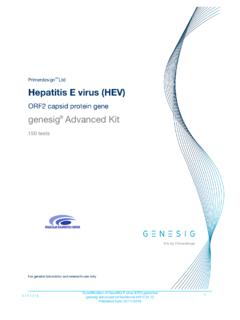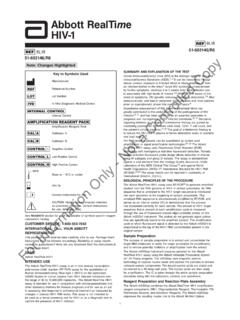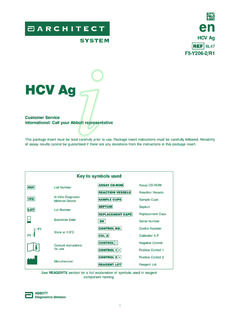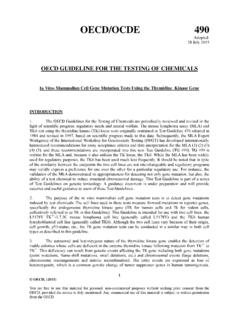Transcription of Guidelines for performing skin tests withdrugs in the ...
1 Contact Dermatitis, 2001, 45, 321 328 Copyright C Munksgaard 2001. Printed in Denmark . All rights reserved ISSN 0105-1873. Review Article Guidelines for performing skin tests with drugs in the investigation of cutaneous adverse drug reactions Proposed by the Working party of the ESCD for the study of skin testing in investigating cutaneous adverse drug reactions A B 1, M G 2, D B 3 A B 4. 1. Dermatology Department, Hopital Fournier, 54000 Nancy, France 2. Dermatology Department, Hospital da Universidade, 3000-075 Coimbra, Portugal 3. Department of Dermatology, Free University Hospital, De Boelelaan 1117, 1081 HV Amsterdam, The Netherlands 4. Allergologische Poliklinik, Kantonsspital, Basel, Switzerland Skin testing with a suspected drug has been reported to be helpful in determining the cause of cutaneous adverse drug reactions (CADR). Many isolated reports of positive drug skin tests are published, but without detailed information concerning the clinical features of the CADR and the method used in performing drug skin tests , such data are not very informative.
2 A working party of the European Society of Contact Dermatitis (ESCD) for the study of skin testing in investigating cutaneous adverse drug reactions, has proposed the herein-reported Guidelines for performing skin testing in CADR in order to standardize these procedures. In each reported case, the imputability of each drug taken at the onset of the CADR and a highly detailed description and characteriza- tion of the dermatitis need to be given. Drug skin tests are performed 6 weeks to 6 months after complete healing of the CADR. Drug patch tests are performed according to the methods used in patch testing in studying contact dermatitis. The commercialized form of the drug used by the patient is tested diluted at 30% pet. (pet.) and/or water (aq.). The pure drug is tested diluted at 10% in pet. or aq. In severe CADR, drug patch tests are performed at lower concentrations.
3 It is also of value to test on the most affected site of the initial CADR. Drug prick tests are performed on the volar forearm skin with the commercialized form of the drug, but with sequential dilutions in cases of urticaria. Intradermal tests (IDT) are performed with sterile sequential dilutions (10 . 4, 10 3, 10 2, 10 1) of a pure sterile or an injectable form of the suspected drug with a small volume of ml. Drug skin tests need to be read at 20 min and also later at D2 and D4 for patch tests , at D1 for prick tests and IDT. All these tests also need to be read at 1 week. The success of skin tests varies with the drug tested, with a high % of positive results, for example, with betalactam antibiotics, pristinamycin, carbamazepine and tetrazepam on patch testing, or with betalactam antibiotics and heparins on delayed readings of IDT. The results of drug skin tests also depend on the clinical features of the CADR.
4 The use of appropriate control patients is necessary to avoid false-positive results. Key words: cutaneous adverse drug reactions; patch testing; prick testing; intradermal testing;. Guidelines . C Munksgaard, 2001. Accepted for publication 29 August 2001. 322 BARBAUD ET AL. Cutaneous adverse drug reactions (CADRs) are a frequent problem in dermatology, especially in Patient Data cases which concern drug imputability, because pa- Besides age, sex and accessory diseases, personal tients are often on multiple drug regimes. Besides or family history of adverse drug reactions, espe- clinical and chronological parameters, there is no cially with the suspected drug or chemically related widely usable complementary test to help estab- drugs, have to be noted. lishing the definite cause of the CADR. Skin testing (patch testing and also prick and intradermal (IDT) testing), with the suspected compound, has been reported to be helpful in de- Drug imputability termining the cause of a CADR (1 5) and in All the drugs taken during the onset of the CADR, studying the pathophysiological mechanisms in- even if they have been prescribed for many volved in these reactions.
5 According to previous months, have to be listed. Imputability for each data, the results of drug skin tests mainly depend drug taken before or during the onset of the skin on the drug tested and the clinical features of the reaction has to be determined according to criteria initial CADR (1, 2, 4 6), but there are, at present, proposed by Moore et al. (7). a few extensive studies that determine the sensi- Clearly, it is of great value to note whether the tivity and specificity of these drug skin tests as a patient has had previous exposure to the suspected complementary tool for drug imputability in drug and to know whether he has had at least 1. CADR. Too many isolated reports of positive drug other episode of similar CADR after taking the skin tests in investigating CADR are published, culprit drug (accidental rechallenge) or if a drug but without detailed information concerning the provocation test has been performed.
6 Other test clinical features of the CADR, the imputability of results, namely positive or negative in vitro tests , the suspected drug, the methods used in perform- such as RAST or a lymphocyte transformation ing drug skin tests , namely the concentrations and test, should also be reported, as they may modify vehicles used for testing the suspected drugs, this the imputability score. data is not always very informative. Moreover, Concerning the suspected drug, the history of there are undoubtedly many negative results that drug intake must be reported with the dates the are not published, which make it still more difficult treatment was begun and stopped, the interval be- to ascertain the sensitivity and specificity of such tween the beginning of drug intake and the onset tests in the study of CADR. of the CADR, the mode of administration, the Therefore, the aim of a working party of the prescribed dosage, the common international no- ESCD for the study of skin testing in investigating menclature of the drug and the disease that it was cutaneous adverse drug reactions was to promote prescribed for.
7 Concurrently, the evolution of the a prospective multicentre study devoted to the use- CADR must be given. fulness of skin testing in CADRs and, also, to pro- pose Guidelines for performing skin testing in CADRs, in order to help standardize this pro- cedure in the investigation of CADR and to assess Characterization of the CADR. their sensitivity and specificity, namely which con- Clinical and evolutive features of the cutaneous ad- cern the suspected drug and the clinico-evolutive verse reaction need to be clearly described. Ad- features of the CADR. ditionally, when possible, the CADR should be classified according to the following: pruritus, urti- caria and/or angioedema, anaphylactoid or ana- phylactic shock, maculopapular and/or purpuric Guidelines in Skin Testing rash, erythroderma (exfoliative dermatitis), hyper- In order to validate the results collected individu- sensitivity syndrome or drug rash with eosino- ally in different centres, skin tests should be per- philia and systemic syndrome (DRESS), pseudo- formed according to common Guidelines , such as lymphoma, generalized or localized eczema, ba- those proposed.
8 Furthermore, it is highly recom- boon syndrome, systemically-induced contact mended that several aspects are considered in each dermatitis, flexural cutaneous adverse drug reac- case, namely concerning data on the patient, on tion, acute generalized exanthematic pustulosis the drugs taken, drug imputability score, clinico- (AGEP), purpura, leucocytoclastic vasculitis, li- evolutive characterization of the CADR and, chenoid dermatosis, erythema multiforme, Stev- eventually, additional data that can be useful in ens-Johnson syndrome, toxic epidermal necrolysis establishing a more strictly defined diagnosis of the (Lyell's syndrome), fixed drug eruptions (FDE) or CADR. eczematous photosensitivity reactions. SKIN tests IN CADR 323. day (D)2 and D4, or, if this is not possible, on D3. Facultative additional data Whenever possible, if the patch tests are negative To improve the diagnosis, the pathophysiological on D4, a reading should be performed on D7.
9 Re- mechanism or to determine whether there is as- sults of patch testing should be reported according sociated organ dysfunction, the following labora- to the International Contact Dermatitis Research tory investigations should be carried out during Group (ICDRG) criteria (9). the CADR: full blood count, platelet count, sedi- In investigating a photosensitivity reaction in- mentation rate, serum creatinine, transaminases, duced by a drug, both drug patch tests and drug alkaline phosphatase, bilirubin, eosinophil cationic photopatch tests with the responsible drug need to protein and tryptase in case of anaphylactoid reac- be performed. Irradiation for drug photopatch tion. Histological examination of a skin biopsy tests should be performed on D1, or for practical performed at the onset of the cutaneous adverse reasons on D2, with 5 J/cm UVA irradiation (10).
10 Drug reaction can be of value in classifying the In fixed drug eruptions (FDE), patch tests clinical and pathophysiological type of CADR. should be performed both on the normal skin of In particular types of CADR, serological tests the back and on the residual pigmented site of the for viral infection that may interfere with the onset FDE (11 13). of the drug eruptions are welcomed, particularly tests for cytomegalovirus, Epstein-Barr virus and parvovirus B19 for patients who have developed a Concentrations and vehicles maculopapular rash, hepatitis B and C for patients Patch testing with the commercialized drug. The with urticaria, Herpes simplex virus hominis type drug possibly responsible for the CADR can be I and II for patients with erythema multiforme, tested with the commercialized form used by the and tests for mycoplasma for patients with Stev- patient.







